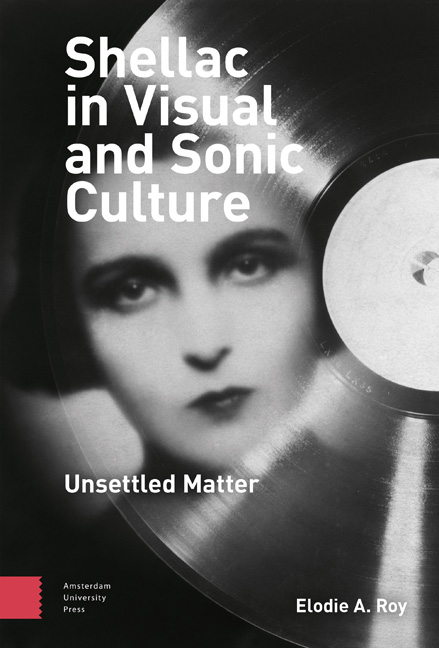Book contents
- Frontmatter
- Contents
- List of illustrations
- Acknowledgements
- Introduction: From material culture to the materials of culture
- 1 Sheen: Early stories and circulation of shellac
- 2 Crackle: Assembling the record
- 3 Mirrors: Phono-fetishism and intersensory visions
- 4 Detonations: Shellac at war
- 5 Shards: Waste, obsolescence, and contemporary remediations
- Conclusion: Sonic sculptures
- Bibliography
- Index
Conclusion: Sonic sculptures
Published online by Cambridge University Press: 17 February 2024
- Frontmatter
- Contents
- List of illustrations
- Acknowledgements
- Introduction: From material culture to the materials of culture
- 1 Sheen: Early stories and circulation of shellac
- 2 Crackle: Assembling the record
- 3 Mirrors: Phono-fetishism and intersensory visions
- 4 Detonations: Shellac at war
- 5 Shards: Waste, obsolescence, and contemporary remediations
- Conclusion: Sonic sculptures
- Bibliography
- Index
Summary
Abstract:
The conclusion briefly revisits the main findings of the book and reasserts the benefits of a combinatory framework for the study of media artefacts. It also tentatively outlines a new approach to the study of phonography, moving from the spectral (or hauntological) conceptual framework (with its insistence on the trace and sonic inscriptibility) to an embodied tactile framework.
Keywords: phonography, hauntology, senses, memory, labour, embodiment
In his poem ‘New Year's Letter (1995)’, Canadian poet Craig Poile writes about the time-dilating experience of painting a friend's home, attentively coating the worn and damaged walls with fresh layers of paint to give them a new lease of life. The poem establishes a parallel between the exteriorised process of painting and the alterations affecting the narrator's mind, as he reflects on time past and the shedding of former selves. Both outer and inner changes are carefully recorded in the medium of the poem, ‘stroke by stroke’. ‘New Year's Letter’ evokes the erasure of past selves and moments, the taking leave of old friends and the emergence of novel relations. The final step, the poet notes, is to varnish the walls with a thin layer of shellac. ‘“Shellac!”‘, he exclaims in the last stanza, ‘seals in the icons as I leave, turning from / the traces of hands going dull on the wall, / the tactile moment where a life takes shape’. The scene is momentarily sealed, yet not completely arrested, and the last word is one of quiet wonder and suspension – an intimation of the unknown, unspent and yet unlived shape of things to come. Poile leaves the future open: the final coat of shellac is still drying as the poet departs.
Poile's poem about painting reminds me of what material culture theorist Thomas J. Schlereth once wrote about the practice and demands of historical writing, comparing it to the carpenter's craft. There is something patient, repetitive, at once technical and intuitive, abstract and embodied, about building a text – about seeking to assemble something which, though inevitably imperfect, will work and stand by itself (at least for a little while).
- Type
- Chapter
- Information
- Shellac in Visual and Sonic CultureUnsettled Matter, pp. 201 - 216Publisher: Amsterdam University PressPrint publication year: 2023



